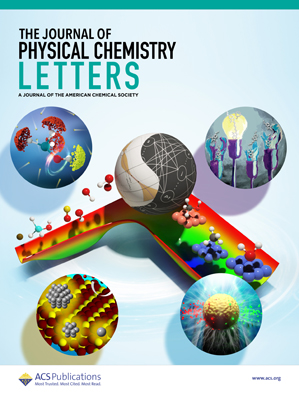阳离子在迪昂-雅各布森型二维有机-无机混合过氧化物相干声子特性中的作用
IF 4.6
2区 化学
Q2 CHEMISTRY, PHYSICAL
引用次数: 0
摘要
二维有机-无机杂化过氧化物(HOIPs)在新一代光伏和发光应用中具有广阔的前景。激子与晶格运动之间复杂的相互作用在决定二维 HOIPs 的激子特性方面发挥着重要作用。然而,对声子和激子-声子(ex-ph)相互作用的调节机制的探索仍然非常有限,尤其是对 Dion-Jacobson (DJ) 型二维 HOIPs。在此,我们利用与温度相关的稳态光谱和时间分辨光谱研究了三种含有不同阳离子的 DJ 型二维 HOIPs:(3AMP)PbI4、(4AMP)PbI4 和 (1,6-HDA)PbI4。研究发现,在 DJ 型二维 HOIP 体系中,阳离子中官能团位置的细微差别以及环状碳链和直链碳链的差异对结构畸变、外相耦合强度甚至带隙随温度的变化趋势都有深远影响。该研究为如何通过对二维包晶结构进行配体修饰来操纵外相间相互作用提供了新的见解。本文章由计算机程序翻译,如有差异,请以英文原文为准。

The Role of Cations in Coherent Phonon Properties in Dion–Jacobson Type 2D Hybrid Organic–Inorganic Perovskites
2D hybrid organic–inorganic perovskites (HOIPs) have great prospects in new-generation photovoltaic and luminescence applications. The complex interaction between exciton and lattice motions plays an important role in determining the exciton properties of 2D HOIPs. However, the exploration of the regulation mechanism of phonons and the exciton–phonon (ex–ph) interaction is still very limited, especially for Dion-Jacobson (DJ) type 2D HOIPs. Here, we investigate three DJ-type 2D HOIPs with different cations, (3AMP)PbI4, (4AMP)PbI4, and (1,6-HDA)PbI4, using temperature-dependent steady-state spectra and time-resolved spectra. It is found that the subtle difference of functional group position in cations and the difference between ring and straight carbon chains have a profound effect on the structural distortion, the ex–ph coupling strength, and even the band gap variation trend with temperature in the DJ type 2D HOIP system. The study provides new insights into how to manipulate ex–ph interactions by targeting ligand modifications to 2D perovskite structures.
求助全文
通过发布文献求助,成功后即可免费获取论文全文。
去求助
来源期刊

The Journal of Physical Chemistry Letters
CHEMISTRY, PHYSICAL-NANOSCIENCE & NANOTECHNOLOGY
CiteScore
9.60
自引率
7.00%
发文量
1519
审稿时长
1.6 months
期刊介绍:
The Journal of Physical Chemistry (JPC) Letters is devoted to reporting new and original experimental and theoretical basic research of interest to physical chemists, biophysical chemists, chemical physicists, physicists, material scientists, and engineers. An important criterion for acceptance is that the paper reports a significant scientific advance and/or physical insight such that rapid publication is essential. Two issues of JPC Letters are published each month.
 求助内容:
求助内容: 应助结果提醒方式:
应助结果提醒方式:


